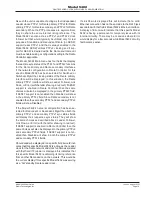
Model 5402 User Guide
Issue 3, August 2021
Studio Technologies, Inc.
Page 9
Model 5402
DANTE LEADER CLOCK WITH GNSS SYNCHRONIZATION
provides moisture protection, but the antenna should not
be left submerged in water. It’s possible that the antenna
will work from inside a building, such as next to a window
or beneath a skylight, but with reduced performance.
The antenna has an integral magnet such that it can self-
affix to a ferrous surface. It also has two mounting holes,
68 millimeters apart center-to-center, that are optimized
for use with M4 or number 8 screws. The antenna includes
a 5-meter (16.3-foot) nominal length of miniature RG174
(50 ohm) coaxial cable terminated with an SMA plug. The
plug must be securely affixed to the SMA jack on the Model
5402’s back panel. The cable must not be crushed and
sharp bends must be avoided. Do not secure the cable
using cable ties such that the cable’s mechanical charac-
teristics are changed.
It’s possible that the antenna’s cable can be extended using
a low-loss, 50-ohm nominal coaxial cable jumper assembly.
These are commercially available from a variety of sources.
The exact characteristics of an extension cable are difficult
to define, however minimizing signal loss is critical. Test-
ing the Model 5402 for proper GNSS reception with the
antenna and proposed cable extender in place is really the
only certain way of ensuring acceptable operation.
The Model 5402 can support the use of other multiband
GNSS antennas. Studio Technologies has tested several
other antennas and they performed very well. Refer to the
Technical Notes section of this guide for details.
Sync Input
An external synchronization source can be connected to
the Model 5402’s sync input BNC jack. Located on the back
panel, this input allows the Model 5402’s internal timing
to be “locked” to an external reference. In most cases,
utilizing the sync input won’t be necessary as the unit’s
GNSS receiver will typically provide an equal or better
timing reference.
Signals that are compatible with the Model 5402’s sync
input include word clock, bi-level video, tri-level video,
and 10 MHz sine wave. A configuration setting in the Sync
Input webpage defines what type of signal is going to be
connected. Another setting defines if a termination imped-
ance is applied to the sync input. Refer to the Specifications
section of this guide for the general characteristics required
of acceptable external sync signals.
A connected word clock signal must be a square wave with
a rate that matches the Dante sample rate as defined in the
Dante Controller application. The rate can be 44.1, 48, 88.2,
96, 176.4, or 192 kHz. If termination has been enabled for
the sync input when it has been configured for word clock
an impedance of 75 ohms will be applied.
A source of bi-level or tri-level video can also be connected
to the sync input. Circuitry within the Model 5402 will de-
code many of the common video rates and formats, allow-
ing them to serve as a timing reference. Refer to Appendix
A, located at the end of this guide, for a list of compatible
rates and formats. If the sync input is configured for video
and termination has been enabled an impedance of 75
ohms will be applied.
A source of 10 MHz sine wave can be connected to the
Model 5402’s sync input. This type of signal is commonly
used as a timing reference in industrial and instrumenta-
tion applications. An impedance of 50 ohms will be applied
to the sync input if termination has been enabled and the
source is selected for 10 MHz.
Word Clock Output
A word clock output signal is provided for use by other
devices that want to be “timed” from the Model 5402.
Available by way of a BNC jack located on the back panel,
the square wave output has a frequency that matches the
unit’s configured Dante sample rate. Choices are 44.1, 48,
88.2, 96, 176.4, and 192 kHz. The exact frequency of the
word clock output is based on the timing reference that has
been selected for the Model 5402. If, for example, GNSS
was selected as the unit’s timing reference, then the word
clock output would be “locked” to it.
The source impedance of the word clock signal is 75 ohms
and its unterminated output level is 5 volts peak-to-peak
(Vpp). When externally terminated with a 75 ohm load the
word clock output level will drop to 2.5 Vpp.
Ethernet Connections
The Model 5402 provides three Gigabit Ethernet (GigE)
ports for flexibility and compatibility with many networking
implementations. Two ports are provided for interconnec-
tions with one or two local area networks (LANs) associated
with Dante audio-over-IP networking schemes. They are
labeled as PRI (primary) and SEC (secondary). The third
Ethernet port, labeled MGMT, can be used to access the
Model 5402 management resources. An internal web server
function supports the Model 5402’s management port’s
webpages. These webpages are used for configuration,
monitoring, and maintenance of Model 5402 operation.
Refer to Figure 3 for an overview of the Model 5402’s three
Ethernet ports and how they can operate.
Using the Dante Controller application, the three Eth-
ernet ports can be configured to operate in one of four
modes: Switched, Redundant, SMgmt, or
ReMgmt. If configured for either the Switched
or Redundant modes the management webpages are ac-
cessed by way of the management Ethernet port. When
configured for the SMgmt mode the management










































